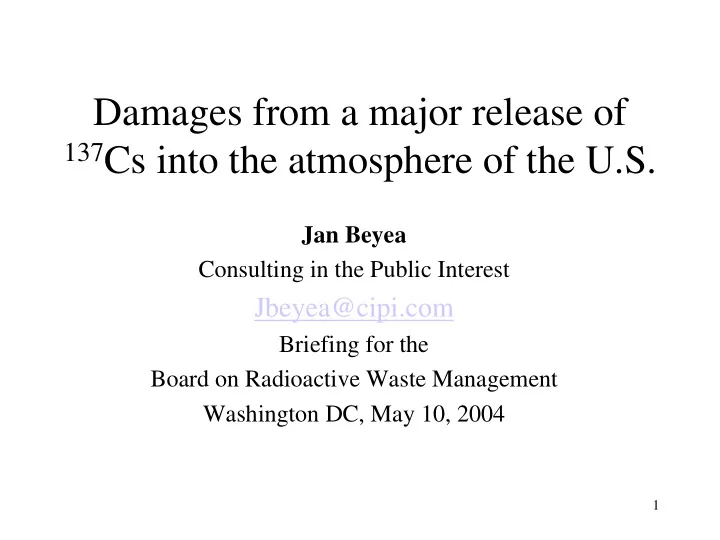

Damages from a major release of 137 Cs into the atmosphere of the U.S. Jan Beyea Consulting in the Public Interest Jbeyea@cipi.com Briefing for the Board on Radioactive Waste Management Washington DC, May 10, 2004 1
Paper to appear in • Science and Global Security • Co-authors: – Edwin Lyman, UCS – Frank von Hippel, Princeton • Addendum to: – “Reducing the hazards from stored spent fuel in the US” – By R. Alvarez, J. Beyea, K. Janberg, J. Kang, E. Lyman, A. Macfarlane, G. Thompson and F. von Hippel 2
Any consequence calculation is assumption dependent • Major assumptions here: – Release magnitude (3.5 and 35 MCi) – Clean-up threshold (15 Ci/km 2 ) – Possible decontamination factors (3-8) – Efficiency of efforts (100%) • Depends on degree of pre-planning – Indirect costs (assumed zero) • Administration, population control, litigation 3
The decision making process for protection of the public could be difficult • because technical aspects of decontamination effectiveness and calculated risk would need to be considered, and • because social/political factors need to be considered. • In the absence of advanced planning, decision makers would need to improvise, – and this could lead to problems and increased costs. From Chanin and Murfin. New 4 material, not in our paper
Manning (1992) describes problems in response to accidents • violations of law, • issuance of inaccurate information, • withholding of information, • tendency of decisionmakers under pressure to make decisions arbitrarily – and then attempt to provide a suitable ex post facto justification. As quoted in Chanin & Murfin 5
• In all of the cases discussed, these problems resulted – when unanticipated events occurred, with a lack of advance planning. – Manning, P. K. (1992), "'Big Bang' Decisions: Notes on a Naturalistic Approach," in The Uses of Discretion, K. Hawkins (ed.), Oxford University Press, New York. 6
NRC’s planning catch-22 • If NRC plans for a spent-fuel release – Nuclear opponents will say it is an admission that such an accident is likely • Perhaps, plan in the context of releases from a dirty bomb? • Clean up standard, in particular, needs to be debated ahead of any accidental release. New material, not in paper 7
• “Existing radiological cleanup laws, regulations, models and criteria must be updated and coordinated – to provide for long-term remediation of radiological dispersal events (“dirty bombs”) – Elcock, D., Klemic, G. A. and Taboas, A. L. Response to a Radiological Dispersal Event (or “Dirty Bomb”). Environ Sci Technol, 2004: 38:2505- 2512. 8
Threshold assumption (15 Ci/km 2 ) and EPA recommended dose limits 137 Cs Contamination Level (Ci/km 2 ) Period Dose (rem) EPA MACCS2 First year after release 2 44.4 41 Second year after release 0.5 17.2 14.4 Cumulative 50-year dose 5 8.2 6 9
Sites considered • Catawba, near Rock Hill, South Carolina; • Indian Point, on the Hudson near NYC; • LaSalle County near Springfield, Il; • Palo Verde, near Prescott, AZ; • Three Mile Island, near Harrisburg, Pa. 10
Average population density Population density around 5 nuclear plants (average) 300 250 200 persons/km 2 150 100 50 0 0 200 400 600 800 1000 1200 1400 1600 1800 kilometers This graph is not in paper 11
Major changes from first paper • Realistic population distributions – which causes estimated (delayed) cancer deaths to come way down. • Improved cost estimates • Corrected discounting error • Economic costs similar • Probably understated 12
Cost estimates • Depend heavily on Chanin & Murfin – Well-thought out study – Tried to be realistic • Major assumptions of C & M: – No administrative and control costs – No errors – Chanin, D. I. and Murfin, W. B. Site restoration: estimation of attributable costs from plutonium-dispersal accidents. Albuquerque: Sandia National Laboratory, 1996, SAND96-0957. 13
Per capita contamination cost assumptions used in our MACCS2 runs Decontamination Factor <3 <8 >8 Decontamination $19,000 $42,000 $0-42,000 Compensation $25,000 $132,000 Relocation 0 $3,600 $3,600 $14,000 $15,000 $0-15,000 Waste disposal $58,000 $85,600 $90,600-135,600 Total 14
Estimates of economic losses ($billions) and cancer deaths Site Release Total Condemned Other Temporary Decontam- Cancer losses 1 ination 2 Deaths 3 (MCi) Costs Property relocation 71 10 32 0 29 3100 Catawba 3.5 35.0 547 145 192 11 199 7650 145 43 42 5 56 1500 Indian 3.5 Point 461 282 85 8 86 5600 35.0 LaSalle 3.5 54 2 23 1 27 2100 270 10 121 7 131 6400 35.0 Palo 3.5 11 1 5 0 5 600 Verde 80 24 26 2 29 2000 35.0 Three- 3.5 171 13 65 6 87 2300 Mile 568 278 134 11 144 7000 35.0 Island Averages 3.5 91 1900 35.0 385 5700 1 Heavily contaminated furnishings, business inventory and vehicles. Also depreciation of property when radioactive decay is required in addition to DF = 8 before reoccupation is possible. 2 Including disposal of radioactive decontamination waste at a cost of $167/m 3 . 3 Assuming an average dose-reduction factor of one third due to shielding by buildings and ground roughness and one cancer death per 2000 whole-body rem population dose. 15
Break-even probability • Was: 0.7 to 5% over next 30 years • Now: 1.4 to 5% • If consider suggestion of Richard Garwin to remove every 5 th assembly, – get 4 times lower cost and 4 times lower break- even probability 16
Remove 1/5th of the assemblies: Then every fuel assembly next to an empty channel, but does not reduce 137 Cs inventory by factor of 4 17
Recommend
More recommend